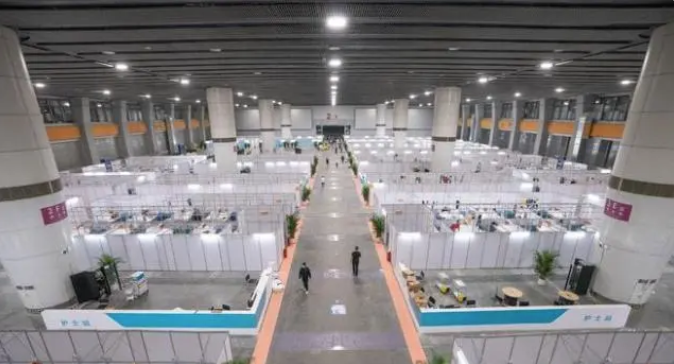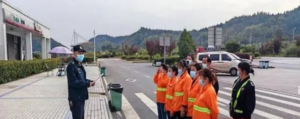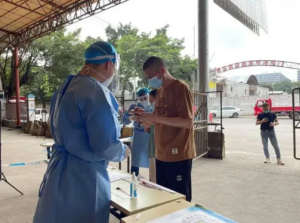
More than 10,000 new infections in Guangzhou in 5 days: Inflection point of the epidemic is difficult to predict, currently in the “containment phase”
Professor Tan said that as things stand, it is still difficult to predict how long this outbreak may last in Guangzhou. So, when does the inflection point of epidemic prevention usually come? “The effect of epidemic prevention and control is often affected by many factors, and if strictly implemented, it will occur in 2-3 infectious periods, one infectious period i.e. 5-7 days.” “According to the prevention and control strategy of infectious diseases, Guangzhou is currently in the containment phase.”
Between 0:00 and 24:00 on November 11, 2022, there were 694 new indigenous confirmed cases in Guangzhou, of which 435 were indigenous asymptomatic to confirmed cases, and 2,921 new indigenous asymptomatic infections. The number of new infections in Guangzhou exceeded 3,000 cases in a single day, and the cumulative number of new infections in 5 days exceeded 10,000.
Outbreak in a highly congregated urban village
The outbreak was concentrated in the Haizhu district of Guangzhou, where 2,555 new cases of indigenous infection with the new coronavirus were reported between 0 and 24 hours on November 9, with 2,369 cases, or 92.7%, added in a single day in Haizhu.
On November 3, Zhang Zhoubin, secretary of the party committee of Guangzhou Center for Disease Control and Prevention, said at the press conference that the new infections in Haizhu district are mainly concentrated in the urban villages of Kecun, Kangle and Lujiang districts, which are densely populated and have a narrow space: “This district, due to the high concentration of industries, brings together a A large number of people, the number of people per square kilometer exceeds 100,000, and there are many handshake buildings in the village, the interior is mostly small streets and narrow alleys, and the air circulation in the whole area is not good.”
Haizhu District issued the latest notice on the evening of November 10, from 0:00 on November 11 to 24:00 on November 13, to further strengthen the prevention and control of the epidemic throughout the region. The notice requires the strengthening of community control, all citizens in principle at home; the notice clearly will strengthen traffic control, subway, bus, cab, online taxi service is suspended.
On November 11, Wuhan University School of Public Health Tan Xiaodong told the People’s Daily Health Client reporter that for such areas, strict closure and control is key, while for infected people, attention should still be paid to preventing acute attacks of serious illness and other underlying diseases.
Inflection point of the epidemic is difficult to predict
“Guangzhou is facing the most complicated and severe epidemic in the three years since the fight against the epidemic.” Zhang Yi said at a news conference on the prevention and control of the epidemic in Guangzhou.
In addition to Haizhu district, the epidemic is developing rapidly in Guangzhou’s Liwan and Panyu districts, and there is still a risk of community spread in the follow-up. on November 10, Zhang Yi introduced that the new infections in Liwan district in the past two days were mainly concentrated in Zhanqian Street and Xicun Street. In addition, sporadic positive cases were found in Longjin and Qiaozhong streets, where the source of infection is still unclear, with many activity tracks and a high risk of community transmission.
Professor Tan Xiaodong said that as things stand, it is still difficult to predict how long this outbreak may last in Guangzhou. So, when does the inflection point of epidemic prevention usually come? “The effect of epidemic prevention and control is often affected by many factors, and if strictly enforced, it will occur in 2-3 transmission periods, one of which is 5-7 days.” Professor Tan Xiaodong said.
Guangzhou epidemic prevention and control is in the “containment phase”
“According to the prevention and control strategy of infectious diseases, Guangzhou is currently in the containment stage.” Professor Tan Xiaodong told People’s Daily Health Client.
The current round of the epidemic in Guangzhou encountered Omicron BA.5.2 mutant strain, which is insidious and spreads fast. In this regard, Guangzhou insists on precise epidemic prevention policy, “the control area conditions are ripe one unblocked one”.
The company’s main business is to provide a wide range of products and services to the public. Five million copies of antigen reagents were distributed to residents throughout the district, inviting them to self-test every day to detect potential sources of infection as early as possible, so that “early detection, early reporting, early disposal”.
“The main task now is to cut off the transmission route and prevent further spread. Guangzhou’s current approach is in line with this strategy, and I believe they will focus all their efforts to solve the problem.” Professor Tan Xiaodong said.
Experts suggest early and accurate, to fight fast
Wuhan University professor of epidemiology and health statistics Yu Chuanhua told the People’s Daily health client reporter: “The newly prevalent strain of Omicron is a new crown strain that is extremely infectious, spreads very fast, and spreads extremely insidiously (asymptomatic, mildly ill people mostly), and currently the neighboring Japan, South Korea, and Taiwan in China are hovering around 30-60,000 new confirmed diagnoses every day. Therefore, the difficulty of prevention and control has increased from the previous period. Medical conditions and awareness of medical care in urban villages are relatively weak, and by the time a positive patient is found, it may have been spreading in that area for some time.”
“Only decisive prevention and control measures with quick control are likely to extinguish the outbreak in time.” Yu Chuanhua suggested, first, strengthening the management of the movement of people in urban villages. Especially during the recent complicated period of the epidemic, try to reduce going out with the gathering of people. Second, play the role of big data, once the identification of gray code red code personnel, need to travel as early as possible to strengthen the management of these people. Third, raise everyone’s awareness of personal protection (wear masks, wash hands regularly, one meter social distance). Actively cooperate with local epidemic prevention personnel in matters such as nucleic acid testing. Fourth, prevent cross-infection in the transfer and centralized square warehouse hospital.


Average Rating